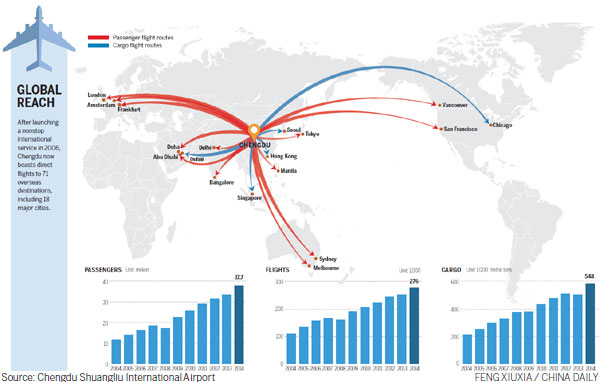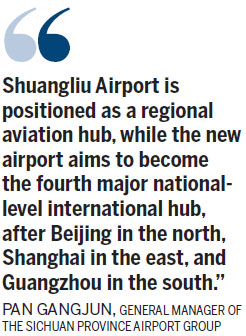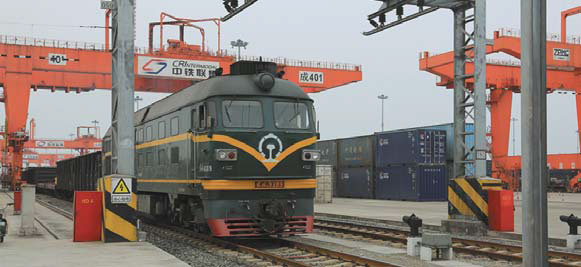New airport set to boost growth
Updated: 2015-07-10 07:27
By Li Fusheng(China Daily Europe)
|
|||||||||||
Increase in flight routes expected to transform city into fourth major national-level international hub
In ancient China, people said traveling to Chengdu was as difficult as taking to the sky. They had no idea that one day flying would be the easiest way for tourists from around the world to reach the capital of Sichuan province in Southwest China.
Shuangliu International Airport in Chengdu has 244 routes to 119 Chinese cities and 71 overseas destinations.

|
The Chengdu-Europe express railway's route, which roughly follows the ancient Silk Road, sets out from Chengdu and runs to Lodz, Poland, 9,826 kilometers away. Photos provided to China Daily |
The airport saw 37.5 million passengers pass through in 2014, ranking it fifth among all 202 civil airports on the Chinese mainland. The figure is expected to reach more than 40 million this year.
Local officials said a new and larger airport will be built and more international air routes will be available, making Sichuan's capital even more closely connected to countries around the world.
The new airport will be located 31 miles southeast of downtown Chengdu and will be larger than Shuangliu Airport.
The facility will make Chengdu the third city on the Chinese mainland to have a second airport, after Beijing and Shanghai.
According to the plans, the first phase of the new airport will be finished by 2018, with annual capacity to handle 40 million passengers and 700,000 metric tons of cargo. The long-term goal is for the airport to handle 90 million passengers and 2 million metric tons of cargo annually.
Highways, subways and intercity railways are also planned to link the new airport to downtown Chengdu and other parts of the city.
General Manager of the Sichuan Province Airport Group, Pan Gangjun, said the new airport would mainly serve international routes, while Shuangliu International Airport will handle domestic flights.
"Shuangliu Airport is positioned as a regional aviation hub, while the new airport aims to become the fourth major national-level international hub," he said.
The construction of a second airport will help create an "air Silk Road" to Europe, said Tang Limin, director of Sichuan's development and reform commission.

Located in the core of Southwest China, the new airport could develop into the largest one on the Silk Road Economic Belt and the Yangtze River Delta Economic Zone, and become China's gateway to Europe, South Asia, Southeast Asia, Central Asia and the Middle East, Pan said.
Chengdu already has the largest number of international routes in China's central and western regions.
The city operates 83 international routes to destinations around the world, including San Francisco, London, Frankfurt, Doha and Melbourne.
On May 2, Sichuan Airlines launched direct routes from Chengdu to Moscow, making it the first city in Southwest China to offer direct flights to the Russian capital.
British Airways and KLM Royal Dutch Airlines promoted their nonstop service between Chengdu and Europe in late May.
United Airlines, which operates the only direct route between western China and the United States, runs a daily nonstop service from Chengdu to San Francisco.
In addition to air transport, Chengdu connects to Europe by an express railway. The rail route, which roughly follows the ancient Silk Road, sets out from Chengdu to Lodz, Poland, 9,826 kilometers away.
Items ranging from shoes to auto parts and computers are collected from Chengdu and other parts of the country and shipped overland to Europe in 12 days.
Chengdu now produces 20 percent of the world's computers and two-thirds of the globe's iPads. Half of the world's laptop computer chips are also encapsulated and tested in the city.
The express rail is part of Chengdu's efforts to turn itself into an international transport hub and realize its goal of becoming China's western gateway to opening-up, officials said.
The line is an artery for economic exchanges between the continents of Asia and Europe and influences the development of China's western region, Europe and Russia.
Since the launch of the Chengdu-Europe express railway in April 2013, commodities worth $580 million have been exported to Europe.
At the intersection of the Silk Road Economic Belt and the Yangtze River Delta Economic Zone, Chengdu itself is "running on a fast track" just like the express, said a local official.
lifusheng@chinadaily.com.cn
(China Daily European Weekly 07/10/2015 page15)
Today's Top News
BRICS 'disappointed' by US failure to ratify IMF reform
BRICS summit condemns WWII 'misrepresentation'
SCO can play major role in Silk Road, Xi says
Stocks surge as government moves to save market
Doubts over heroes' authenticity grow with widening Internet access
Sun and sand is where the wealthy from Chinese mainland head
Chinese stocks plunge to three-month low
Macedonia expects first mutiple unit train from China
Hot Topics
Lunar probe , China growth forecasts, Emission rules get tougher, China seen through 'colored lens', International board,
Editor's Picks

|

|

|

|

|

|







